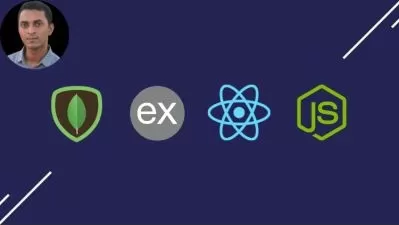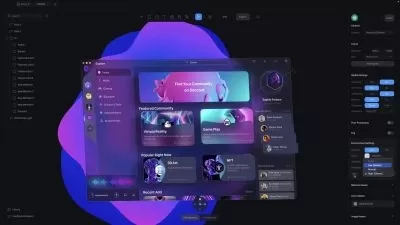Microfrontends with React: A Complete Developer's Guide
Stephen Grider
9:00:55
Description
Build incredibly scalable apps with a microfrontend architecture
What You'll Learn?
- Use microfrontends to architect an app that dozens of teams can work on at the same time
- Structure your apps to scale to millions of users
- Understand how to divide a monolithic app into multiple sub-apps
- Coordinate data exchanged between your microfrontends
- Apply a production-style workflow with a full CI/CD pipeline
- Deploy your microfrontends to Amazon Web Services with CloudFront
- Isolate rules styling by applying CSS-scoping techniques
- Judge whether microfrontends are an appropriate choice for your application
Who is this for?
What You Need to Know?
More details
DescriptionCongratulations! You've found the most popular, most complete, and most up-to-date resource online for learning how to use microfrontends!
Thousands of other engineers have learned microfrontends, and you can too. This course uses a time-tested, battle-proven method to make sure you understand exactly how microfrontends work, and will get you a new job working as a software engineer or help you build that app you've always been dreaming about.
The difference between this course and all the others: you will understand the design patterns used by top companies to build massively popular web apps.
Microfrontends are used to divide a large app into a series of smaller apps. This provides a set of unique benefits to any frontend:
Author smaller, easier to understand codebases
Use a different set of libraries for each sub-app - bring the best tool for the job!
Deploy each portion separately - limit the chance of interrupting your users
Allow each of your engineering teams to work independently
This new architecture is popular, but there is a lot of misinformation online. This course has been developed with input from top engineers to ensure total technical accuracy. Additionally, you'll learn how to evaluate whether microservices are a good choice for your application.
----------------------
What will you build?
This course features hundreds of videos with dozens of custom diagrams to help you understand how microfrontends work. No prior experience is necessary. Through tireless, patient explanations and many interesting practical examples, you'll learn the fundamentals of building dynamic and live web apps using microfrontends.
Each topic included in this course is added incrementally, to make sure that you have a solid foundation of knowledge. You'll find plenty of discussion added in to help you understand exactly when and where to use each aspect of microfrontends.
Below is a partial list of the topics you'll find in this course:
Learn design patterns used by the largest companies in the world
Understand when to use microfrontends
Link multiple apps together using a tiered routing system
Scope CSS on your page to prevent cross-app contamination
Avoid sharing state between apps to promote isolation
Deploy each portion of your app independently to avoid production bugs
Scaffold a CI/CDÂ pipeline to automate your release process
Utilize multiple front-end frameworks in the same app
Maximize performance by using module federation
I built this course to save you hundreds of hours of self study. I've put years of my own experience into this course to save you time. Sign up today and join me in mastering microfrontends.
Who this course is for:
- Engineers looking to scale frontend apps
Congratulations! You've found the most popular, most complete, and most up-to-date resource online for learning how to use microfrontends!
Thousands of other engineers have learned microfrontends, and you can too. This course uses a time-tested, battle-proven method to make sure you understand exactly how microfrontends work, and will get you a new job working as a software engineer or help you build that app you've always been dreaming about.
The difference between this course and all the others: you will understand the design patterns used by top companies to build massively popular web apps.
Microfrontends are used to divide a large app into a series of smaller apps. This provides a set of unique benefits to any frontend:
Author smaller, easier to understand codebases
Use a different set of libraries for each sub-app - bring the best tool for the job!
Deploy each portion separately - limit the chance of interrupting your users
Allow each of your engineering teams to work independently
This new architecture is popular, but there is a lot of misinformation online. This course has been developed with input from top engineers to ensure total technical accuracy. Additionally, you'll learn how to evaluate whether microservices are a good choice for your application.
----------------------
What will you build?
This course features hundreds of videos with dozens of custom diagrams to help you understand how microfrontends work. No prior experience is necessary. Through tireless, patient explanations and many interesting practical examples, you'll learn the fundamentals of building dynamic and live web apps using microfrontends.
Each topic included in this course is added incrementally, to make sure that you have a solid foundation of knowledge. You'll find plenty of discussion added in to help you understand exactly when and where to use each aspect of microfrontends.
Below is a partial list of the topics you'll find in this course:
Learn design patterns used by the largest companies in the world
Understand when to use microfrontends
Link multiple apps together using a tiered routing system
Scope CSS on your page to prevent cross-app contamination
Avoid sharing state between apps to promote isolation
Deploy each portion of your app independently to avoid production bugs
Scaffold a CI/CDÂ pipeline to automate your release process
Utilize multiple front-end frameworks in the same app
Maximize performance by using module federation
I built this course to save you hundreds of hours of self study. I've put years of my own experience into this course to save you time. Sign up today and join me in mastering microfrontends.
Who this course is for:
- Engineers looking to scale frontend apps
User Reviews
Rating
Stephen Grider
Instructor's Courses
Udemy
View courses Udemy- language english
- Training sessions 108
- duration 9:00:55
- English subtitles has
- Release Date 2023/06/12
















